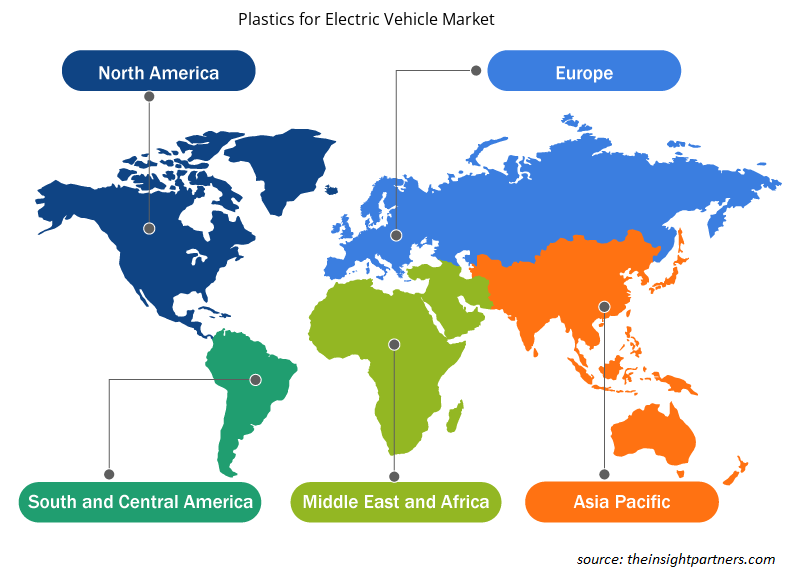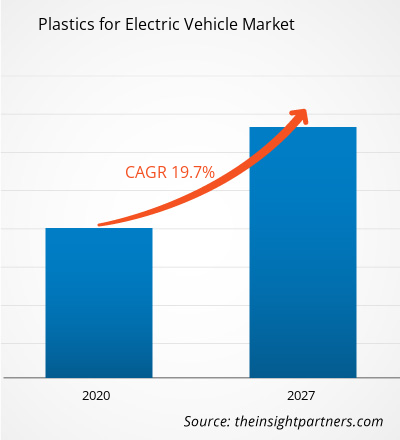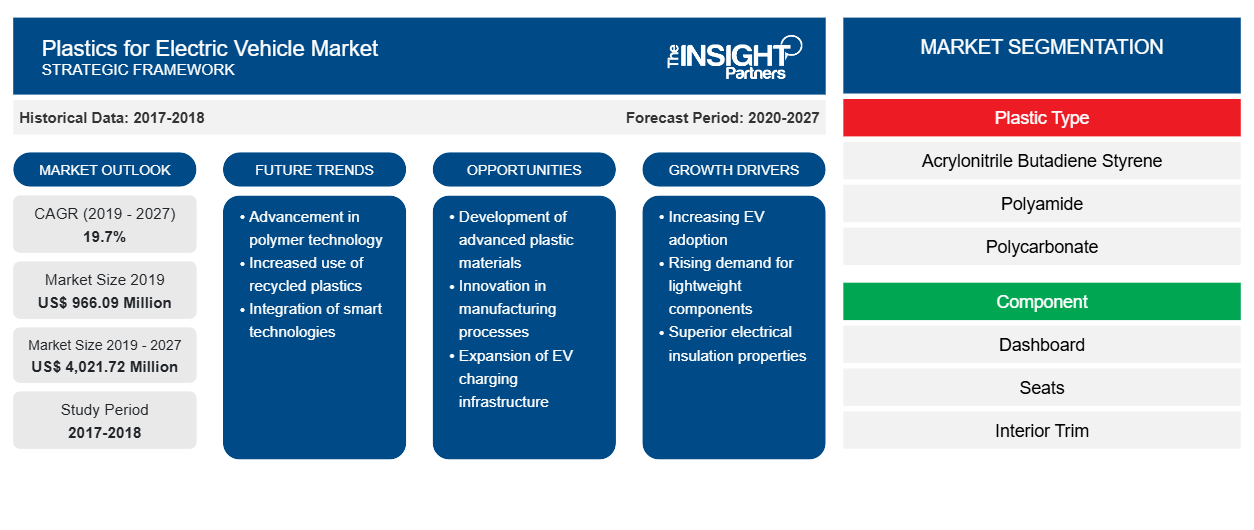Der Markt für Kunststoffe für Elektrofahrzeuge hatte im Jahr 2019 einen Wert von 966,09 Millionen US-Dollar und soll bis 2027 einen Wert von 4.021,72 Millionen US-Dollar erreichen; von 2020 bis 2027 dürfte er mit einer durchschnittlichen jährlichen Wachstumsrate von 19,7 % wachsen.
Kunststoffe können elektrische Leiter und auch Isolatoren sein. Aufgrund der hohen Vielseitigkeit und einfachen Formbarkeit von Kunststoffen können thermoplastische Polymere je nach den Anforderungen von Elektrofahrzeugen in verschiedenen Formen und Ausführungen hergestellt werden. Die Verwendung von Kunststoffen für Elektrofahrzeuge reduziert das Gewicht dieser Fahrzeuge, was eine größere Reichweite zwischen den Aufladungen ermöglicht. Kunststoffe bieten eine hervorragende Hitzebeständigkeit, die den Bau von Batteriefächern und Kühlsystemen ermöglicht und die Haltbarkeit und Sicherheit von Elektrofahrzeugen nicht beeinträchtigt. Der globale Markt für Kunststoffe für Elektrofahrzeuge in Nordamerika wird voraussichtlich im Zeitraum 2020–2027 mit einer durchschnittlichen jährlichen Wachstumsrate von 20,0 % wachsen.
Die COVID-19-Pandemie wurde erstmals im Dezember 2019 in Wuhan (China) gemeldet. Seit Juni 2020 gehören die USA, Russland, Indien, Spanien, Brasilien, Italien, Frankreich und Deutschland zu den am schlimmsten betroffenen Ländern in Bezug auf die Anzahl der COVID-19-Fälle und gemeldeten Todesfälle. Der Ausbruch wirkt sich aufgrund von Lockdowns, Reiseverboten und Betriebsschließungen negativ auf Volkswirtschaften und Industrien aus. Die Chemie- und Materialindustrie ist eine der weltweit wichtigsten Industrien, die unter ernsthaften Störungen in Form von Lieferkettenunterbrechungen, Absagen von Technologieveranstaltungen und Büroschließungen leidet. China ist das globale Produktionszentrum und der größte Rohstofflieferant für verschiedene Industrien auf der ganzen Welt und auch eines der am schlimmsten von der COVID-19-Pandemie betroffenen Länder. Die Schließung verschiedener Werke und Fabriken in China schränkt die globalen Lieferketten sowie die Herstellung und den Verkauf verschiedener Chemikalien und Materialprodukte ein. Die Gesamtauswirkungen der Pandemie bremsen folglich das Wachstum des Marktes für Kunststoffe für Elektrofahrzeuge.
Passen Sie diesen Bericht Ihren Anforderungen an
Sie erhalten kostenlos individuelle Anpassungen an jedem Bericht, einschließlich Teilen dieses Berichts oder einer Analyse auf Länderebene, eines Excel-Datenpakets sowie tolle Angebote und Rabatte für Start-ups und Universitäten.
-
Holen Sie sich die wichtigsten Markttrends aus diesem Bericht.Dieses KOSTENLOSE Beispiel umfasst eine Datenanalyse von Markttrends bis hin zu Schätzungen und Prognosen.
Markteinblicke
Steigende Nachfrage nach Elektrofahrzeugen treibt Marktwachstum an
Der Automobilbau konzentriert sich zunehmend auf die Erzeugung von weniger Treibhausgasemissionen und Kraftstoffeffizienz, wobei die ökologische Nachhaltigkeit immer mehr im Vordergrund steht. Kosteneffizienz, ökologische Nachhaltigkeit, Komfort, Einsatz moderner Technologie und verschiedene staatliche Maßnahmen wie Vorzugstarife, Anreize für den Gerätekauf und erhebliche Rabatte sind einige der Faktoren, die die Nachfrage nach Elektrofahrzeugen weltweit ankurbeln. Laut IEA wurde im Jahr 2019 ein Anstieg von 40 % gegenüber dem Vorjahr verzeichnet, wobei weltweit 2,1 Millionen Elektroautos verkauft wurden, was den Absatz von 2018 deutlich übertrifft.
Einblicke in Kunststoffarten
Basierend auf der Kunststoffart ist der Markt für Kunststoffe für Elektrofahrzeuge in Acrylnitril-Butadien-Styrol (ABS), Polyamid (PA), Polycarbonat (PC), Polyvinylbutyral, Polyurethan (PU), Polypropylen (PP) und andere unterteilt. Das Segment Polypropylen (PP) hatte 2019 den größten Marktanteil. Polypropylen (PP) ist ein thermoplastisches „Additionspolymer“, das durch die Kombination von Propylenmonomeren hergestellt wird. Es ist starr und kristallin; daher wird es häufig zur Herstellung von Gegenständen wie Verpackungsschalen, medizinischen Geräten und anderen verwendet. Als Teil der wichtigen Familie der Polyolefinharze wird es in jede Kunststoffart geformt und extrudiert, die Flexibilität, Zähigkeit, geringes Gewicht und Hitzebeständigkeit erfordert.
Einblicke in Komponenten
Basierend auf den Komponenten ist der Markt für Kunststoffe für Elektrofahrzeuge in Armaturenbrett, Sitze, Innenverkleidung, Autopolster, Stoßfänger und andere unterteilt. Das Segment Innenverkleidung hatte 2019 den größten Marktanteil. Die Innenverkleidung eines Elektrofahrzeugs bezieht sich auf die Kunststoffkomponenten oder -platten, die in der Kabine vorhanden sind. Funktionelle und ästhetische Verkleidungen mit ansprechenden Merkmalen sind für ein perfektes Innenraumerlebnis unerlässlich.
Einblicke in den Fahrzeugtyp
Basierend auf dem Fahrzeugtyp ist der Markt für Kunststoffe für Elektrofahrzeuge in BEV und PHEV/HEV unterteilt. Das BEV-Segment hatte 2019 den größten Marktanteil. Batterieelektrische Fahrzeuge oder BEVs speichern Strom an Bord mit hochleistungsfähigen Batteriepaketen. Die Energie in der Batterie wird verwendet, um den Elektromotor und andere Elektronik an Bord zu betreiben. Kunststoffe werden zur Herstellung von Steckverbindern und Gehäusen für die elektrischen Komponenten verwendet, die in Elektrofahrzeugen benötigt werden.
Anwendungseinblicke
Basierend auf der Anwendung ist der Markt für Kunststoffe für Elektrofahrzeuge weiter segmentiert in Antriebsstrangsystem/Motorhaube, Exterieur, Interieur sowie Beleuchtung und elektrische Verkabelung. Das Interieursegment hatte 2019 den größten Marktanteil. Hochleistungskunststoffe werden in Elektrofahrzeugen verwendet, um Sicherheit und Schutz zu gewährleisten. Polypropylen wird häufig in Autoteilen wie Benzinkanistern und Teppichfasern des Innenraumbodens verwendet. PVC wird aufgrund seiner glatten Oberfläche in Autotanks und Armaturenbrettern verwendet. Lenkräder und Armaturenbretter werden auch aus Acrylnitril-Butadien-Styrol oder ABS-Kunststoffen hergestellt. Die weit verbreitete Anwendung von Kunststoffen in Lenkrädern, Innenraumböden und Konsolen begünstigt das Wachstum des Marktes für Kunststoffe für Elektrofahrzeuge im Bereich der Innenausstattung.
Regionale Einblicke in den Markt für Kunststoffe für Elektrofahrzeuge
Die regionalen Trends und Faktoren, die den Markt für Kunststoffe für Elektrofahrzeuge im Prognosezeitraum beeinflussen, wurden von den Analysten von Insight Partners ausführlich erläutert. In diesem Abschnitt werden auch die Marktsegmente und die Geografie von Kunststoffen für Elektrofahrzeuge in Nordamerika, Europa, im asiatisch-pazifischen Raum, im Nahen Osten und Afrika sowie in Süd- und Mittelamerika erörtert.

- Erhalten Sie regionale Daten zum Markt für Kunststoffe für Elektrofahrzeuge
Umfang des Marktberichts über Kunststoffe für Elektrofahrzeuge
| Berichtsattribut | Details |
|---|---|
| Marktgröße im Jahr 2019 | 966,09 Millionen US-Dollar |
| Marktgröße bis 2027 | 4.021,72 Millionen US-Dollar |
| Globale CAGR (2019 - 2027) | 19,7 % |
| Historische Daten | 2017-2018 |
| Prognosezeitraum | 2020–2027 |
| Abgedeckte Segmente |
Nach Kunststoffart
|
| Abgedeckte Regionen und Länder |
Nordamerika
|
| Marktführer und wichtige Unternehmensprofile |
|
Dichte der Marktteilnehmer für Kunststoffe für Elektrofahrzeuge: Auswirkungen auf die Geschäftsdynamik verstehen
Der Markt für Kunststoffe für Elektrofahrzeuge wächst rasant. Dies wird durch die steigende Nachfrage der Endverbraucher aufgrund von Faktoren wie sich entwickelnden Verbraucherpräferenzen, technologischen Fortschritten und einem größeren Bewusstsein für die Vorteile des Produkts vorangetrieben. Mit der steigenden Nachfrage erweitern Unternehmen ihr Angebot, entwickeln Innovationen, um die Bedürfnisse der Verbraucher zu erfüllen, und nutzen neue Trends, was das Marktwachstum weiter ankurbelt.
Die Marktteilnehmerdichte bezieht sich auf die Verteilung der Firmen oder Unternehmen, die in einem bestimmten Markt oder einer bestimmten Branche tätig sind. Sie gibt an, wie viele Wettbewerber (Marktteilnehmer) in einem bestimmten Marktraum im Verhältnis zu seiner Größe oder seinem gesamten Marktwert präsent sind.
Die wichtigsten Unternehmen auf dem Markt für Kunststoffe für Elektrofahrzeuge sind:
- BASF SE
- Solvay SA
- DuPont de Nemours, Inc.
- Die Dow Chemical Company
- LG Chem Ltd
Haftungsausschluss : Die oben aufgeführten Unternehmen sind nicht in einer bestimmten Reihenfolge aufgeführt.

- Überblick über die wichtigsten Akteure auf dem Markt für Kunststoffe für Elektrofahrzeuge
Bericht-Spotlights
- Fortschrittliche Branchentrends auf dem globalen Markt für Kunststoffe für Elektrofahrzeuge, die den Akteuren bei der Entwicklung wirksamer langfristiger Strategien helfen
- In Industrie- und Entwicklungsländern angewandte Strategien für Unternehmenswachstum
- Quantitative Analyse des Marktes für Kunststoffe für Elektrofahrzeuge von 2017 bis 2027
- Schätzung des Kunststoffbedarfs für Elektrofahrzeuge in verschiedenen Branchen weltweit
- PEST-Analyse zur Veranschaulichung der Wirksamkeit der auf dem Markt tätigen Käufer und Lieferanten
- Aktuelle Entwicklungen zum Verständnis der Wettbewerbssituation auf dem Markt und der Nachfrage nach Kunststoffen für Elektrofahrzeuge
- Markttrends und -aussichten sowie Faktoren, die das Marktwachstum vorantreiben und bremsen
- Verständnis der Strategien, die dem globalen Wachstum des Marktes für Kunststoffe für Elektrofahrzeuge zugrunde liegen und die den Beteiligten bei der Entscheidungsfindung helfen
- Kunststoff für Elektrofahrzeuge Marktgröße an verschiedenen Marktknoten
- Detaillierte Übersicht und Segmentierung des Marktes sowie der Branchendynamik
- Die globale Marktgröße für Kunststoffe für Elektrofahrzeuge ist in verschiedenen Regionen mit vielversprechenden Wachstumschancen in diesen Regionen
Kunststoff für den Elektrofahrzeugmarkt, nach Kunststoffart
- Acrylnitril-Butadien-Styrol
- Polyamid
- Polycarbonat
- Polyvinylbutyral
- Polyurethan
- Polypropylen
- Sonstiges
Kunststoff für den Elektrofahrzeugmarkt, nach Komponenten
- Armaturenbrett
- Sitzplätze
- Innenausstattung
- Autopolster
- Stoßstange
- Sonstiges
Kunststoff für den Elektrofahrzeugmarkt, nach Fahrzeugtyp
- BEV
- PHEV/HEV
Kunststoff für Elektrofahrzeuge Markt, nach Anwendung
- Antriebsstrangsystem/Unter der Motorhaube
- Exterieur
- Innere
- Beleuchtung und Elektroinstallation
Firmenprofile
- BASF SE
- Solvay SA
- DuPont de Nemours, Inc.
- Die Dow Chemical Company
- LG Chem Ltd.
- Lanxess AG
- Sabic
- Covestro AG
- Asahi Kasei Corporation
- Lyondellbasell Industries Holdings BV
- Historische Analyse (2 Jahre), Basisjahr, Prognose (7 Jahre) mit CAGR
- PEST- und SWOT-Analyse
- Marktgröße Wert/Volumen – Global, Regional, Land
- Branchen- und Wettbewerbslandschaft
- Excel-Datensatz
Aktuelle Berichte
Verwandte Berichte
Erfahrungsberichte
Grund zum Kauf
- Fundierte Entscheidungsfindung
- Marktdynamik verstehen
- Wettbewerbsanalyse
- Kundeneinblicke
- Marktprognosen
- Risikominimierung
- Strategische Planung
- Investitionsbegründung
- Identifizierung neuer Märkte
- Verbesserung von Marketingstrategien
- Steigerung der Betriebseffizienz
- Anpassung an regulatorische Trends























 Kostenlose Probe anfordern für - Kunststoffe für den Elektrofahrzeugmarkt
Kostenlose Probe anfordern für - Kunststoffe für den Elektrofahrzeugmarkt